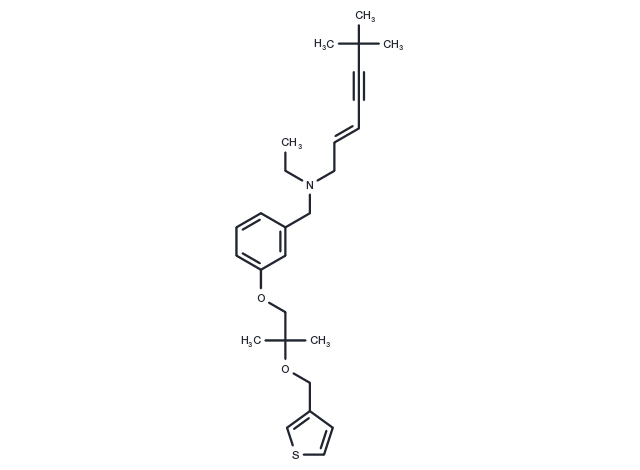Powder: -20°C for 3 years | In solvent: -80°C for 1 year


FR194738 free base inhibits squalene epoxidase activity in HepG2 cell homogenates with an IC50 of 9.8 nM.

| Pack Size | Availability | Price/USD | Quantity |
|---|---|---|---|
| 1 mg | In stock | $ 233.00 | |
| 5 mg | In stock | $ 497.00 | |
| 10 mg | In stock | $ 723.00 | |
| 25 mg | In stock | $ 1,130.00 | |
| 50 mg | In stock | $ 1,520.00 | |
| 100 mg | In stock | $ 1,980.00 | |
| 1 mL * 10 mM (in DMSO) | In stock | $ 547.00 |

| Description | FR194738 free base inhibits squalene epoxidase activity in HepG2 cell homogenates with an IC50 of 9.8 nM. |
| Targets&IC50 | SE (HepG2 cell homogenates):9.8 nM |
| In vitro | FR194738 free base potently inhibits squalene epoxidase in HepG2 cell homogenate and liver microsomes in dogs and rats. FR194738 free base inhibits hamster liver microsomal squalene epoxidase activity in a concentration-dependent manner with an IC50 of 14 nM[2]. In intact HepG2 cells, FR194738 free base inhibits the incorporation of [14C]acetate into free cholesterol and cholesteryl ester in a concentration-dependent manner(IC50s = 4.9 and 8.0 nM). FR194738 free base induces intracellular [14C]squalene accumulation and increases the incorporation of [14C]acetate into squalene[3]. |
| In vivo | FR194738 free base reduces the serum levels of total, non high density lipoprotein and high density lipoprotein cholesterol, and triglyceride. In hamsters, FR194738 free base(32 mg/kg) increases HMG-CoA reductase activity by 1.3-fold[2]. |
| Molecular Weight | 439.65 |
| Formula | C27H37NO2S |
| CAS No. | 204067-45-8 |
Powder: -20°C for 3 years | In solvent: -80°C for 1 year
DMSO: 90 mg/mL (204.7 mM), Sonification is recommended.
You can also refer to dose conversion for different animals. More
bottom
Please see Inhibitor Handling Instructions for more frequently ask questions. Topics include: how to prepare stock solutions, how to store products, and cautions on cell-based assays & animal experiments, etc.
FR194738 free base 204067-45-8 Microbiology/Virology Antifungal FR 194738 FR194738 FR-194738 free base FR-194738 inhibitor inhibit
